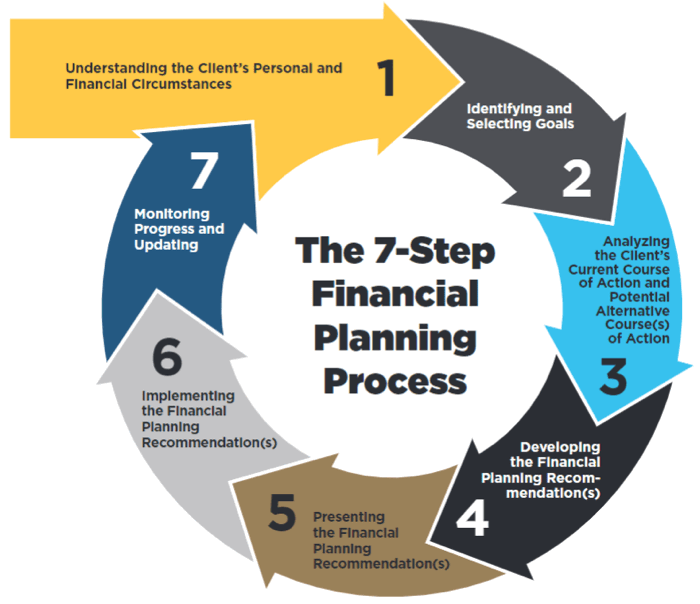
Whew! 😅 I just passed my first mid-term test in about 20 years. The first half of Fundamentals of Financial Planning, the first course from my self-paced CFP program, included coverage of the official 7-Step “Financial Planning Process”. The image above was found in my course materials, but the text (and I believe the graphic itself) is from the CFB Board’s Financial Planning Practice Standards.
Below are my completely non-official notes and takeaways. Remember, this is from the perspective of the financial planner.
Step 1: Understanding the Client’s Personal and Financial Circumstances
- You must explain, obtain, and analyze all of the qualitative and quantitative information needed to fulfill the scope of your engagement.
- Qualitative topics include (but are not limited to) health, family, goals, risk-tolerance, and priorities.
- Quantitive topics include (but are not limited to) income, expenses, cashflow, savings, investments, assets, liabilities (debts), estate plans, and retirement/work benefits.
- If the client is unwilling or unable to provide sufficient and accurate information (both personal and financial), you must terminate the engagement.
Step 2: Identifying and Selecting Goals
- Identify potential goals for the client, using the information gathered in Step 1.
- This means that in addition to the goals the clients brings up themselves, you may find other ones like adequate life insurance or a clear estate plan.
- After developing this list of potential goals, work with the client to select and prioritize amongst these goals.
Step 3: Analyzing the Client’s Current Course of Action and Potential Alternative Courses of Action
- Analyze the client’s current course of action. What are they doing now? Will their goals be met this way?
- Analyze potential alternative courses of action. Find at least one alternative for any goal that won’t be met with current action.
Step 4: Developing the Financial Planning Recommendations
- Develop a specific recommendation of action for each selected goal. It’s possible that the recommendation is to “stay the course” for one or more goals.
- If an alternative is presented, work out why it is better than the current action. Include any assumptions and estimates used in your calculations.
- Consider if each specific recommendation is independent or must be implemented along with another recommendation.
Step 5: Presenting the Financial Planning Recommendations
- Present your recommendations to the clients. Your goal is to have the client understand all of the factors that were considered and why the recommendation presented is the best recommendation.
Step 6: Implementing the Financial Planning Recommendations
- Now that the recommended actions have been agreed upon, who is responsible for implementation? Might be you (the financial planner), might be the client.
- What products, actions, or services are the most appropriate for the job?
- Select and implement!
Step 7: Monitoring Progress and Updating
- Who is responsible for monitoring and updating? Might be you (the financial planner), might be the client.
- If you (the financial planner) is responsible for monitoring and updating, then you must regularly monitor the client’s progress and keep the process going. Update with current client information, update goals, update recommendations, etc.
Other random thoughts:
The CFP Board makes a big deal about the difference between “Financial Advice” and “Financial Planning”. Financial Advice is the more limited act of making a recommendation to act or not to act, often focused on a specific niche topic. On the other end, the most encompassing (and expensive) term is Financial Planning, which requires you to follow all their Standards and obtain a deep understanding of the client’s personal and financial situation. Accordingly, CFPs will ask you to sign an Engagement Letter that clearly outlines the services and products being provided (and how you’ll pay for them).
I also spent a good deal of time learning how to use the HP-12C financial calculator to solve for internal rates of return, time value of money, cash flow analysis, amortization, and other financial scenarios. I have an engineering background, but had never used this calculator before, so I had to order a new one online. In the meantime, I used an HP-12C emulator to do the coursework. It’s definitely handy for finance.
 The Best Credit Card Bonus Offers – 2025
The Best Credit Card Bonus Offers – 2025 Big List of Free Stocks from Brokerage Apps
Big List of Free Stocks from Brokerage Apps Best Interest Rates on Cash - 2025
Best Interest Rates on Cash - 2025 Free Credit Scores x 3 + Free Credit Monitoring
Free Credit Scores x 3 + Free Credit Monitoring Best No Fee 0% APR Balance Transfer Offers
Best No Fee 0% APR Balance Transfer Offers Little-Known Cellular Data Plans That Can Save Big Money
Little-Known Cellular Data Plans That Can Save Big Money How To Haggle Your Cable or Direct TV Bill
How To Haggle Your Cable or Direct TV Bill Big List of Free Consumer Data Reports (Credit, Rent, Work)
Big List of Free Consumer Data Reports (Credit, Rent, Work)
Wishing you continued success with good health and prosperity.
HP 12 c, have one,
———- but that link, emulator hp-12c, very nice, will bookmark
—————- and use more , thank you mymoneyblog, sir.
tue. 20 feb. 2024 ,
______________________________________